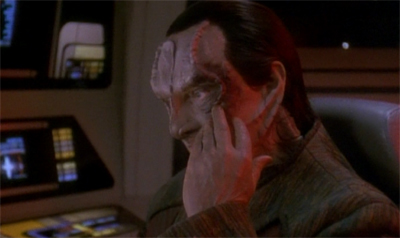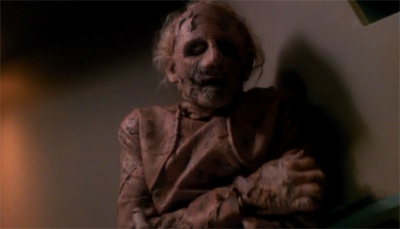Penumbra represents the beginning of the end, kicking off the epic ten-episode conclusion to Star Trek: Deep Space Nine.
To be fair, Deep Space Nine had already embraced serialised storytelling, whether in the seeding of gradually-building plotlines or its long-term character development. The show was most serialised in the audacious six-episode arc that opened the sixth season; A Time to Stand, Rocks and Shoals, Sons and Daughters, Behind the Lines, Favour the Bold and Sacrifice of Angels. In some ways, the ten-episode closing arc is ultimately an extension of that basic idea. However, it is also something more complex.

When the moon is in the seventh house in the Kendra Province…
In some ways, this last narrative experiment would be the boldest creative decision of the entire seven year run. The production team had strained a little bit in structuring and pacing those six linked episodes; Sons and Daughters was notably the runt of the litter, telling a relatively standalone story about Worf while essentially repeating Kira’s character arc from Rocks and Shoals in a much less effective manner. As such, trying to tie ten hours of television together into a single cohesive narrative was a bold move. Then again, Deep Space Nine had never been short of ambition.
It is tempting to treat this ten-episode run as a single story, and it kinda is; Netflix labels the forty-five minute episodes as “Part 1”, “Part 2”, “Part 3”, “Part 4”, “Part 5”, “Part 6”, “Part 7” and “Part 8.” However, the run can also be broken down into smaller chunks. ‘Til Death Do Us Part and Strange Bedfellows were originally titled Umbra and Eclipse, suggesting a three-parter. In contrast, TV Guide listed the first four episodes in the run as a four-parter. When It Rains… and Tacking Into the Wind are definitely a two-parter. Extreme Measures is practically standalone.

Build a final arc.
Admittedly, the storytelling falters in places, as the production team’s reach occasionally exceeds their grasp. Some of these issues are outside the control of the production team, such as the budgetary concerns that hinder Extreme Measures. Some of these issues are entirely within the control of the production team, such as the pacing of the subplot with Winn and Dukat that leads to the most transparent stalling tactic in When It Rains…. Individual story choices are occasionally misguided, such as the emphasis on the Breen or the Pah-Wraiths.
Nevertheless, these ten episodes hang together surprisingly well. There is a sense of purpose and momentum running through these episodes that strengthens even the weaker hours. More than that, this ten-part saga includes some of the strongest episodes in the entire franchise, with episodes like When It Rains… and Tacking Into the Wind feeling like the culmination of more than nine years of storytelling across two different series. Though individual elements of this sprawling epic might miss the mark, the whole is greater than the sum of its parts.

The Dukat is of Bajor…
Filed under: Deep Space Nine | Tagged: deep space nine, Emissary, foreshadowing, long-form storytelling, penumbra, serialisation, set-up, star trek, star trek: deep space nine | Leave a comment »




























